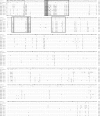Heterogeneity in spike protein genes of porcine epidemic diarrhea viruses isolated in Korea
- PMID: 20132850
- PMCID: PMC7114470
- DOI: 10.1016/j.virusres.2010.01.015
Heterogeneity in spike protein genes of porcine epidemic diarrhea viruses isolated in Korea
Abstract
Porcine epidemic diarrhea virus (PEDV) has plagued the domestic swine industry in Korea causing significant economic impacts on pig production nationwide. In the present study, we determined the complete nucleotide sequences of the spike (S) glycoprotein genes of seven Korean PEDV isolates. The entire S genes of all isolates were found to be nine nucleotides longer in length than other PEDV reference strains. This size difference was due to the combined presence of notable 15 bp insertion and 6 bp deletion within the N-terminal region of the S1 domain of the Korean isolates. In addition, the largest number of amino acid variations was accumulated in the S1 N-terminal region, leading to the presence of hypervariability in the isolates. Sequence comparisons at the peptide level of the S proteins revealed that all seven Korean isolates shared diverse similarities ranging from a 93.6% to 99.6% identity with each other but exhibited a 92.2% to 93.7% identity with other reference strains. Collectively, the sequence analysis data indicate the diversity of the PEDV isolates currently prevalent in Korea that represents a heterogeneous group. Phylogenetic analyses showed two separate clusters, in which all Korean field isolates were grouped together in the second cluster (group 2). The results indicate that prevailing isolates in Korea are phylogenetically more closely related to each other rather than other reference strains. Interestingly, the tree topology based on the nucleotide sequences representing the S1 domain or the S1 N-terminal region most nearly resembled the full S gene-based phylogenetic tree. Therefore, our data implicates a potential usefulness of the partial S protein gene including the N-terminal region in unveiling genetic relatedness of PEDV isolates.
(c) 2010 Elsevier B.V. All rights reserved.
Figures




Similar articles
-
Sequence analysis of the partial spike glycoprotein gene of porcine epidemic diarrhea viruses isolated in Korea.Virus Genes. 2007 Oct;35(2):321-32. doi: 10.1007/s11262-007-0096-x. Epub 2007 Apr 11. Virus Genes. 2007. PMID: 17436070
-
Genomic and antigenic characterization of porcine epidemic diarrhoea virus strains isolated from South Korea, 2017.Transbound Emerg Dis. 2018 Aug;65(4):949-956. doi: 10.1111/tbed.12904. Epub 2018 May 16. Transbound Emerg Dis. 2018. PMID: 29770590 Free PMC article.
-
Detection and phylogenetic analysis of porcine epidemic diarrhea virus in central China based on the ORF3 gene and the S1 gene.Virol J. 2016 Nov 25;13(1):192. doi: 10.1186/s12985-016-0646-8. Virol J. 2016. PMID: 27887624 Free PMC article.
-
Isolation and characterization of Chinese porcine epidemic diarrhea virus with novel mutations and deletions in the S gene.Vet Microbiol. 2018 Jul;221:81-89. doi: 10.1016/j.vetmic.2018.05.021. Epub 2018 Jun 6. Vet Microbiol. 2018. PMID: 29981713 Free PMC article.
-
Complete genome sequences of novel S-deletion variants of porcine epidemic diarrhea virus identified from a recurrent outbreak on Jeju Island, South Korea.Arch Virol. 2019 Oct;164(10):2621-2625. doi: 10.1007/s00705-019-04360-4. Epub 2019 Jul 26. Arch Virol. 2019. PMID: 31350613 Free PMC article.
Cited by
-
Porcine Epidemic Diarrhea Virus: An Updated Overview of Virus Epidemiology, Virulence Variation Patterns and Virus-Host Interactions.Viruses. 2022 Nov 2;14(11):2434. doi: 10.3390/v14112434. Viruses. 2022. PMID: 36366532 Free PMC article. Review.
-
New emergence pattern with variant porcine epidemic diarrhea viruses, South Korea, 2012-2015.Virus Res. 2016 Dec 2;226:14-19. doi: 10.1016/j.virusres.2016.06.013. Epub 2016 Jun 21. Virus Res. 2016. PMID: 27345861 Free PMC article.
-
Genomic and epidemiological characteristics provide new insights into the phylogeographical and spatiotemporal spread of porcine epidemic diarrhea virus in Asia.J Clin Microbiol. 2015 May;53(5):1484-92. doi: 10.1128/JCM.02898-14. Epub 2015 Feb 18. J Clin Microbiol. 2015. PMID: 25694517 Free PMC article.
-
Genetic variation analysis of reemerging porcine epidemic diarrhea virus prevailing in central China from 2010 to 2011.Virus Genes. 2013 Apr;46(2):337-44. doi: 10.1007/s11262-012-0867-x. Epub 2012 Dec 27. Virus Genes. 2013. PMID: 23269482 Free PMC article.
-
The Characterization and Pathogenicity of a Recombinant Porcine Epidemic Diarrhea Virus Variant ECQ1.Viruses. 2023 Jun 30;15(7):1492. doi: 10.3390/v15071492. Viruses. 2023. PMID: 37515178 Free PMC article.
References
-
- Chang S.H., Bae J.L., Kang T.J., Kim J., Chung G.H., Lim C.W., Laude H., Yang M.S., Jang Y.S. Identification of the epitope region capable of inducing neutralizing antibodies against the porcine epidemic diarrhea virus. Mol. Cells. 2002;14:295–299. - PubMed
-
- Debouck P., Pensaert M. Experimental infection of pigs with a new porcine enteric coronavirus, CV777. Am. J. Vet. Res. 1980;41:219–223. - PubMed
-
- Duarte M., Laude H. Sequence of the spike protein of porcine epidemic diarrhea virus. J. Gen. Virol. 1994;75:1195–1200. - PubMed
Publication types
MeSH terms
Substances
Associated data
- Actions
- Actions
- Actions
- Actions
- Actions
- Actions
- Actions
LinkOut - more resources
Full Text Sources
Other Literature Sources

